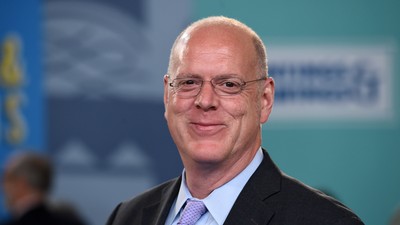Bakshaish Rug, ca. 1880
 Watch
Watch
GUEST:
Somewhere probably ten or so years after the turn of the century, it was given to my great-grandmother and great-grandfather as a wedding present. They lived in Detroit at the time, and it pretty quickly ended up in their house in Maine, where it stayed until probably the mid-'90s. And when my grandparents passed on, it wound up under our couch, and that's where it's been.
APPRAISER:
It's a Northwest Persian rug-- present-day Iran, but made in Persia-- from an area that we call Bakshaish, which is a rural countryside area so they make things that aren't very fancy. They're very stylized and abstract, as you can see here. Although we know a lot about Bakshaish rugs, in 25 years of being in the rug trade, I've only seen three other examples of this design. So it's an outrageously rare design type. And what it represents is the area in Northwest Persia where the Bakshaish rugs were made. It was a mountainous area with forests, abundant floral and fauna. And what you have is a herd of antelope, and it's probably representing the migration between summer and winter pastures of the wild antelope that were driven and herded by the people who lived in the region. There was a lot of abstraction in the way they interpreted things. So when you see, like, the antelope floating in the night sky, it's not Santa's reindeer, it's just another antelope. And the trees represent the local trees, these are cypress trees. These are very stylized pomegranate trees. And color-wise, it's really just what the weaver liked. I mean, I'm calling this a night sky, but that's my own interpretation. It's late 19th century, 1880s, 1890s, somewhere in that range. And it's interesting that your grandparents had it. At the turn of the century, a folk art rug like this wouldn't have been as popular as a more city, urban rug. Has anyone ever given you a sense of value?
GUEST:
The last person, which was six or seven years ago probably, said somewhere between $12,000 and $15,000 but he really didn't know if that was low or high.
APPRAISER:
Right, right.
GUEST:
He basically said he had no real way to tell.
APPRAISER:
I would say a conservative auction estimate for this would be $25,000 to $35,000.
GUEST:
Okay.
APPRAISER:
With a chance of it actually bringing much more. The other three that I mentioned, one sold for almost $100,000, but it had a white background, which is a lot rarer and a lot more desirable. And then the other ones have sold in that $25,000 to $40,000, $45,000 range. So I think a nice, conservative auction estimate would be $25,000 to $35,000.
GUEST:
Well, that is certainly not too shabby.
APPRAISER:
No, it's a good thing. It's a very good rug and really in remarkably good condition.
Appraisal Details

Executive producer Marsha Bemko shares her tips for getting the most out of ANTIQUES ROADSHOW.
Value can change: The value of an item is dependent upon many things, including the condition of the object itself, trends in the market for that kind of object, and the location where the item will be sold. These are just some of the reasons why the answer to the question "What's it worth?" is so often "It depends."
Note the date: Take note of the date the appraisal was recorded. This information appears in the upper left corner of the page, with the label "Appraised On." Values change over time according to market forces, so the current value of the item could be higher, lower, or the same as when our expert first appraised it.
Context is key: Listen carefully. Most of our experts will give appraisal values in context. For example, you'll often hear them say what an item is worth "at auction," or "retail," or "for insurance purposes" (replacement value). Retail prices are different from wholesale prices. Often an auctioneer will talk about what she knows best: the auction market. A shop owner will usually talk about what he knows best: the retail price he'd place on the object in his shop. And though there are no hard and fast rules, an object's auction price can often be half its retail value; yet for other objects, an auction price could be higher than retail. As a rule, however, retail and insurance/replacement values are about the same.
Verbal approximations: The values given by the experts on ANTIQUES ROADSHOW are considered "verbal approximations of value." Technically, an "appraisal" is a legal document, generally for insurance purposes, written by a qualified expert and paid for by the owner of the item. An appraisal usually involves an extensive amount of research to establish authenticity, provenance, composition, method of construction, and other important attributes of a particular object.
Opinion of value: As with all appraisals, the verbal approximations of value given at ROADSHOW events are our experts' opinions formed from their knowledge of antiques and collectibles, market trends, and other factors. Although our valuations are based on research and experience, opinions can, and sometimes do, vary among experts.
Appraiser affiliations: Finally, the affiliation of the appraiser may have changed since the appraisal was recorded. To see current contact information for an appraiser in the ROADSHOW Archive, click on the link below the appraiser's picture. Our Appraiser Index also contains a complete list of active ROADSHOW appraisers and their contact details and biographies.













